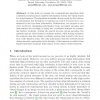Free Online Productivity Tools
i2Speak
i2Symbol
i2OCR
iTex2Img
iWeb2Print
iWeb2Shot
i2Type
iPdf2Split
iPdf2Merge
i2Bopomofo
i2Arabic
i2Style
i2Image
i2PDF
iLatex2Rtf
Sci2ools
ICNC
2005
Springer
2005
Springer
Visual Search for Object Features
In this work we present the computational algorithm that combines perceptual and cognitive information during the visual search for object features. The algorithm is initially driven purely by the bottomup information but during the recognition process it becomes more constrained by the top-down information. Furthermore, we propose a concrete model for integrating information from successive saccades and demonstrate the necessity of using two coordinate systems for measuring feature locations. During the search process, across saccades, the network uses an object-based coordinate system, while during a fixation the network uses the retinal coordinate system that is tied to the location of the fixation point. The only information that the network stores during saccadic exploration is the identity of the features on which it has fixated and their locations with respect to the object-centered system.
| Added | 27 Jun 2010 |
| Updated | 27 Jun 2010 |
| Type | Conference |
| Year | 2005 |
| Where | ICNC |
| Authors | Predrag Neskovic, Leon N. Cooper |
Comments (0)

